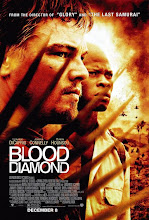In the case of conflict diamonds, the media was the tool that a group of small NGOs used to propel the issue onto the global agenda. The media was one of the first targets of these NGOs, specifically newspapers. The coalition Fatal Attraction (discussed in the previous blog) sent editors of large newspapers fake diamond rings in jewelers’ boxes with information on how diamonds fueled wars in Africa (Grant and Taylor). Through my research, this campaign seems to have been effective in attracting the media’s attention- specifically the major Western newspapers.
It is first important to note how I conducted my research. By using the search engine LexisNexis, I was able to track the chronological order in which larger news sources began reporting on the issue of conflict diamonds. By using LexisNexis, I decided to focus my attention on the medium of newspapers and journals. I performed a search on “conflict diamonds” in the past 15 years. The results of my search seem to prove a relationship between the actions of Fatal Action and the issue adoption of major news sources.
Global Witness released their first report on the issue, “A Rough Trade: The Role of Companies and Governments in the Angolan Conflict,” in 1998. In October of 1999, Fatal Transaction began its campaign. (Grant and Taylor). Between the release of the initial report and the start of the Campaign, only a handful of articles were written about the issue. The majority of these articles were written for Africa News, and some of them were written by Global Witness. In The New York Times on August 8, 1999 a short editorial was published: “The Business of War in Africa,” but it wasn’t until October of 1999 that I observed a proliferation of major newspapers reporting on this issue; such as The Times (London), Sydney Morning Herald, The Washington Post, Newsweek, The Economist and the UN began issuing reports to Africa News. I think the proliferation of attention this issue received from the media can be attributed to Fatal Attraction’s campaign, and not as just a mere coincidence.
After the issue grabbed the media’s attention, the UN signed the resolution on conflict diamonds on December 1, 2000. My research showed that between October 1999 and December 2000, 167 articles had been written about conflict diamonds. I think it is safe to state that the UN passed the resolution in part due to the pressure the global media.
The major newspapers and journals have continued to follow the issue through the establishment of the Kimberely Process, and the release of the movie Blood Diamond. Below is the number of hits my search received from the major news sources on the issue of “conflict diamonds” in the past 15 years:
The New York Times: 27
The Times (London): 36
The Washington Post: 19
Newsweek: 5
The Economist: 3
Overall for Magazines, Journals, and Newspapers: 568
The work of Fatal Attraction and other NGOs properly attracted the attention of the written media. Without the attention and cooperation of these major media outlets, the issue of conflict diamonds may have never made it to the global agenda.
References:
Grant, Andrew, and Ian Taylor. "Global Governance and Conflict Diamonds: The Kimberley Process and the Quest for Clean Gems." The Round Table 93 (2004): 385-401.
Subscribe to:
Post Comments (Atom)



3 comments:
What your team is doing on this blog is very interesting and useful. Would you please contact me? Marc Choyt, publisher, fairjewelry.org. email: www.fairjewelry.org
Dear Mandy, I am currently in the process of writing my dissertation which is on
'changing conception of the luxury: the diamond market- To what extent has media exposure influenced society's focus on ethical consumption within diamond industry'
I came across your blog which has been very interesting, particularly your article entitled 'the media's role in putting conflict diamond on the global agenda'. I was wondering if firstly i maybe able to use you as a reference in my dissertation in order to refer to the research you did through LexisNexis, but secondly if I do, then I can't use your blogsite in my bibliography. Do you therefore have any suggestions of how I can cite your work (if you don't mind!)
many thanks.
Olivia
(contact: or7636@bris.ac.uk)
Your blog provides us very great information. Its really very helpful to me.
loose diamonds canada
Post a Comment